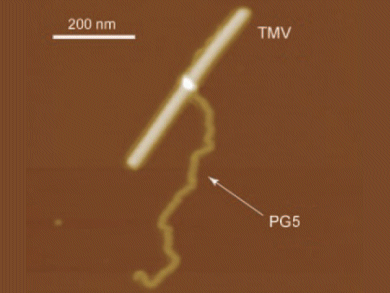Largest Macromolecule
Organic Chemists have always been trying to imitate biology. Although it is possible to make many molecules that imitate biomolecules in terms of structure and function, it remains a challenge to attain the size and form of large biomolecules. An international team led by A. Dieter Schlüter at the ETH Zurich, Switzerland, has introduced a branched polymer that resembles the tobacco mosaic virus in size and cylindrical form. According to the researchers, this is the largest synthetic macromolecule with defined shape and atomic structure reported to date.
Previously, the largest reported synthetic structures with a defined atomic structure were polystyrene polymers with a molecular mass of about 40 million Daltons. However, this value corresponds to a small fraction of the mass of large DNA molecules. Formation of a large synthetic molecule that also has a defined form is much more difficult. For biologists, however, it is routine. Even the simplest organism has a well-defined form, such as the rod-shaped tobacco mosaic virus (TMV). For chemists it is a model: a massive molecular ensemble with perfect control over its chemical structure, function, size, and molecular form.
Model Virus
Schlüter and co-workers have now presented a branched polymer that approximates the size and form of the tobacco mosaic virus. Their complex synthesis, which requires 170,000 bond-forming reactions in a single molecule, led to a structurally defined, linear macromolecule with a diameter of about 10 nm and a molecular weight of 200 million Daltons. It thus has a molar mass, cross section, and cylindrical form comparable to the tobacco mosaic virus.
The new macromolecule is a dendronized polymer: it consists of a linear backbone with highly and regularly branched side chains. “This is the biggest synthetic macromolecule with a defined chemical structure and defined form to date,” according to Schlüter. “Our experiment is a first step toward the synthesis of molecular objects.” A structure is considered to be an object if it keeps its form regardless of its environment, when its interior can be distinguished from the outer environment, and when there is a clear boundary between the two. There are many synthetic nano-objects, however these are not single molecules, but are aggregates of several or many individual molecules.
Image: macromolecule, PG5, embracing the tobacco mosaic virus (TMV). (c) Wiley-VCH
- The Largest Synthetic Structure with Molecular Precision: Towards a Molecular Object
B. Zhang, R. Wepf, K. Fischer, M. Schmidt, S. Besse et al.,
Angew. Chem. Int. Ed. 2011.
DOI: 10.1002/anie.201005164




